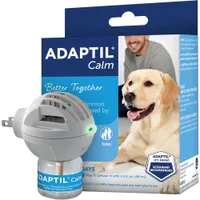Renting with pets: Your questions answered
It can be difficult to know where to start when renting with pets, but this guide can help.

About a third of people in the US live in rented properties – that’s more than 100 million people. And many of these are pet parents.
There’s a lot to consider when renting with pets – and this is true whether you’re looking to give a pet a forever home for the first time or you’re currently looking for a new rental property and you have pets already.
If you’re lucky enough to live in one of the most pet-friendly US states for renters then you’re you’re in luck because renting can be stressful even before you bring pets into the equation, so where do you begin? Let’s take a look, with some insights from vet Dr. Hannah Godfrey and financial wellness expert Miranda Marquit.
Finding pet-friendly properties
First of all, does your landlord allow you to have pets? Recent research from HireAHelper has found that, in the US, almost three-quarters (73.2%) of rental listings allow pets, which is promising.
But this can differ from area to area. In Colorado, for example, 86.3% of listings allow pets, whereas just 33.2% of listings in Hawaii do. And pet parents in different countries can find things more difficult. For example, data in the UK indicates that only 7% of rental properties are advertised as pet-friendly.
You might be looking to rent in your current city or state, but if you’re open to moving further afield, it might be a good idea to look at more pet-friendly areas – you might have more options open to you. Why not take a look at the top US cities to have a dog and the top US cities to have a cat?
Furthermore, many of the cities that have more pet-friendly properties can be pet-friendly in other aspects, too.
Get the best advice, tips and top tech for your beloved Pets
Take Austin and Plano in Texas, for example. They’re two of the cities with the highest proportion of pet-friendly rental listings, and Austin has plenty of dog-friendly restaurants and bars. Plano, meanwhile, is a certified Better City For Pets, with organizations working to end pet homelessness, amenities like free poop bags, and, again, plenty of dog-friendly businesses to visit with your pup!
What to look for in a property
“Will there be adequate outdoor access to allow your dog or cat to toilet outside, or will you need to provide your cat with a couple of litter boxes?” asks Dr. Godfrey. “Where are the nearest open spaces or dog-friendly areas for walks? And will the new property’s size and layout accommodate your pet’s necessities, like beds, scratching posts, litter boxes, food, and water?”
Miranda advises looking for properties that are easy to care for – easy-to-clean floors are a better bet than carpeted floors, for example, while Dr. Godfrey stresses the importance of making sure that the property is secure, particularly if there’s a balcony or it’s near a busy road.
Remember to be upfront about your pet, too. Moving into a non-pet-friendly property and sneaking a pet in can lead to consequences that could include a loss of your deposit and even potentially eviction. It’s important to be transparent.
Keeping on good terms with your landlord
On that note, it’s a good idea to make sure you remain on positive terms with your landlord through the tenancy and get off on the right foot, too.
“Ask your landlord about fees,” says Miranda. “Sometimes, you can negotiate an upfront pet deposit instead of a monthly fee. A landlord willing to work with you, especially if you can provide proof of an obedience class or a reference from a past landlord – reassuring the landlord that your pet is well-behaved and isn’t likely to cause any issues – can help you as you look at properties.”
Pet insurance can also reassure a landlord. While it primarily covers veterinary costs and healthcare, some policies include third-party liability, which can cover damages your pet causes.
Pets can damage furniture, walls, and carpets. That’s just part and parcel of having them. If you’re moving into a furnished property and your pet damages the furniture – perhaps you have a cat who likes to scratch things other than scratching posts – part of your deposit may go toward cleaning or repairs after you leave.
“Document the state of the rental ahead of time,” says Miranda, “And make sure you report any current damage and items of concern. That way, when you move out, you have a comparison and you can show that your pet did minimal damage.”
And, if you’re living in an apartment block, be considerate of your neighbors, too!
How to support your pet with the move
Moving is a big change for anyone, and your pets are no exception – this is true whether you’re moving to somewhere you own or whether it’s somewhere you’re renting. We’ve put together some tips on how to move house with a cat and preparing to move house with a dog.
Dr. Godfrey suggests using pet calming products for a few weeks before the move, and continuing with them until they’ve settled. And, if you’re making a long journey in the car or on the train to your new property, you might want to speak to your vet about how to make it easier for them – particularly if your pet is prone to travel sickness or doesn’t have much experience of travel. Cat and dog travel sickness isn’t fun for us or our pets!
Keep as many things the same as you can – feed them the same dog or cat food, make sure they have their normal bed, and keep their favorite toys nearby. Familiarity will help reassure them and avoid stress.
This is the top vet-recommended solution to help calm and relax your dog at home. It works by mimicking a mother dog’s natural nursing pheromones, helping your dog to feel calm and comfortable.
Your pet might be quite unsettled at first – and this could mean a couple of little accidents. “Prepare for this and try to keep your cool,” says Dr. Godfrey, “Because becoming angry or giving them an emotional reaction is only likely to make them more stressed.”
However, if your pet still seems unsettled after a few weeks, it might be a good idea to speak to your vet for more advice.
Renting with a service animal
If you have a service animal, make sure you know your rights. The Fair Housing Act states that landlords can’t charge additional fees for a certified service animal.
However, with emotional support animals, the process is a little different, explains Miranda. “If you have a letter from a licensed mental health professional, you might be able to receive accommodation and avoid additional pet rent fees.”
If you’re planning on moving a dog into your rented property, here’s how to puppy-proof your house and yard and how to pet-proof your rental

Adam is a freelance journalist specialising in pets, music and culture, and mental health and wellbeing. He investigates and writes the large majority of news on PetsRadar, and collaborates with veterinary experts to produce informative pet care content.
Adam has a journalism degree from Southampton Solent University and a masters degree in Magazine Journalism from Cardiff University. He was previously senior editor at dog advice website DogTime.com, and has also written for The Independent, GoodToKnow and Healthline.
He owns two rescue cats, Bunny and Dougie, and has also previously had a rabbit, fish and Roborovski dwarf hamsters.

